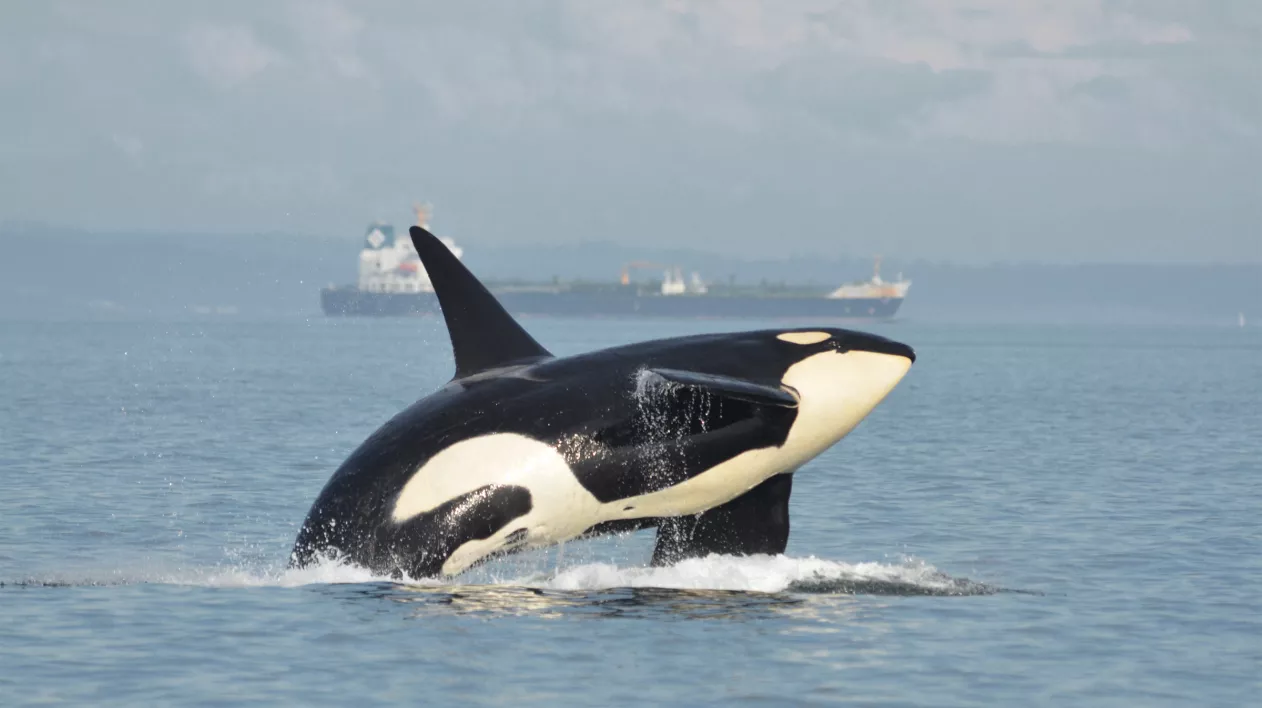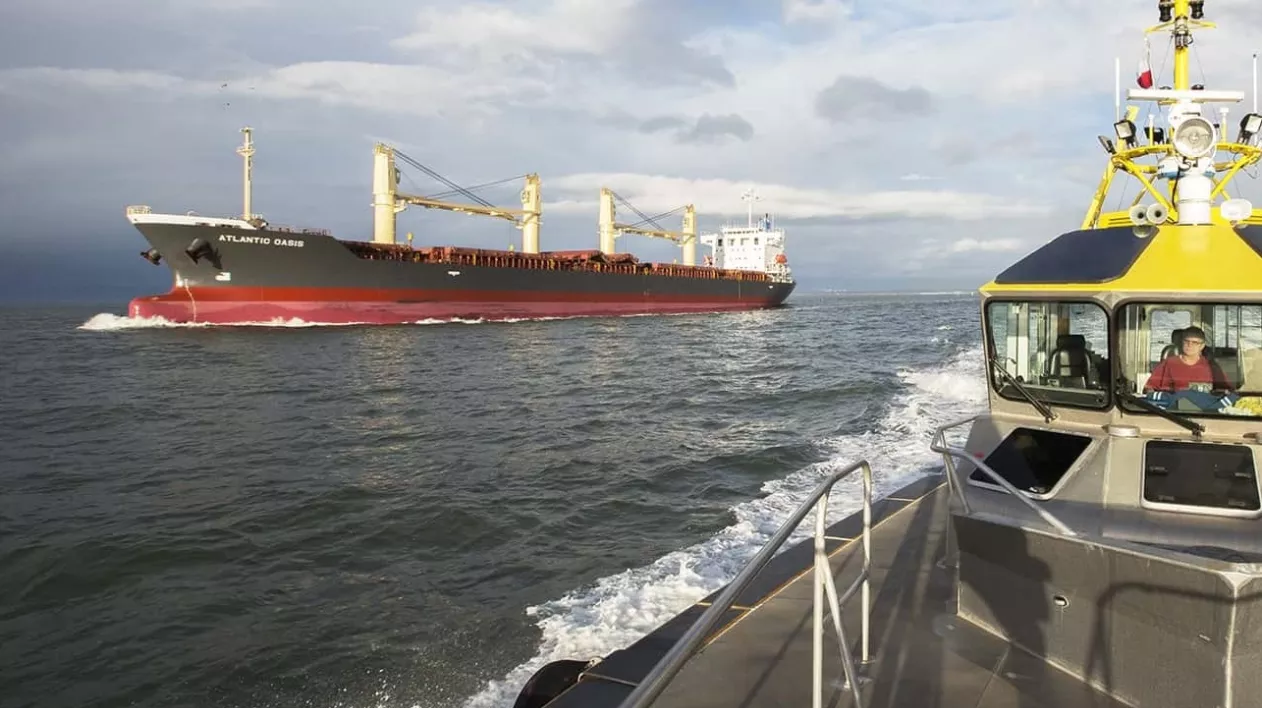
ECHO Program projects and initiatives
The Enhancing Cetacean and Habitat Observation (ECHO) Program coordinates voluntary, seasonal measures to reduce the impacts of commercial shipping on at-risk whales off British Columbia’s southern coast. While the ECHO Program’s focus is on acoustic disturbance—one of the four key threats to southern resident killer whales identified by Fisheries and Oceans Canada—the program also supports other threat reduction projects related to physical disturbance and environmental contaminants, including the:
- Haro Strait and Boundary Pass voluntary ship slowdown
- Strait of Juan de Fuca voluntary inshore lateral displacement
- Swiftsure Bank voluntary ship slowdown
For more information about these and other ECHO Program initiatives, please read the annual report.
The cumulative participation rate, based on the number of individual ship transits, was 86% across all three measures – which translates to more than 5,700 slower or more distanced ship transits within key areas of southern resident killer whale critical habitat. In total, more than 100 marine transportation organizations voluntarily participated in the ECHO Program’s measures.
Partners and advisors
The ECHO Program is guided by the advice and input of an advisory working group and associated technical committees.
We are grateful for the ongoing support, guidance, and contributions of our many advisors, partners, and collaborators, whose efforts continue to help reduce the cumulative effects of marine shipping on at-risk whales.
- BC Coast Pilots
- BC Ferries
- Canadian Coast Guard
- Chamber of Shipping
- Council of Marine Carriers
- Cruise Lines International Association – North West & Canada
- Fisheries and Oceans Canada
- Indigenous advisors
- National Oceanic and Atmospheric Administration
- Natural Resources Defense Council, Inc.
- Ocean Wise
- Pacific Pilotage Authority
- Royal Canadian Navy
- Shipping Federation of Canada
- Transport Canada
- Vancouver Fraser Port Authority
- Washington State Ferries
- WWF-Canada
- BC Coast Pilots
- BC Ferries
- Canadian Coast Guard
- Chamber of Shipping
- Council of Marine Carriers
- Cruise Lines International Association – North West & Canada
- Hapag-Lloyd (Canada) Inc.
- Holland America Group
- Marine Exchange of Puget Sound
- Pacific Merchant Shipping Association
- Pacific Northwest Ship & Cargo Services
- Pacific Pilotage Authority
- Royal Canadian Navy
- Shipping Federation of Canada
- Transport Canada
- U.S. Coast Guard
- Vancouver Fraser Port Authority
- Washington State Ferries
- BC Ferries
- Fisheries and Oceans Canada
- DHI Group Inc.
- DW Ship Consult
- JASCO Applied Sciences
- National Oceanic Atmospheric Administration (NOAA)
- NOAA Olympic Coast National Marine Sanctuary
- Oceans Network Canada
- Ocean Wise
- Royal Canadian Navy
- Robert Allan Naval Architects
- Saturna Cetacean Sighting Network
- Sea Mammal Research Unit Consulting Canada
- Transport Canada
- University of British Columbia
- University of St. Andrews
- University of Victoria
- Washington State Department of Transportation
- Achieve Quieter Oceans
- American Waterways Operators
- Green Marine
- Nanaimo Port Authority
- Port of Seattle
- Port of Tacoma
- Prince Rupert Port Authority
- JASCO Applied Sciences
- Oceans Networks Canada
- Makah Tribe
- Pacheedaht First Nation
- Puget Sound Pilots
- Saturna Island Marine Research and Education Society
- Scripps Institute of Oceanography
- Sea Mammal Research Unit Consulting Canada
- Tsleil-Waututh Nation
- University of Victoria – Noise Exposure to the Marine Environment from Ships Project
- The Whale Museum
- Vancouver Fraser Port Authority
- Fisheries and Oceans Canada
- Fraser River Pile and Dredge
- Trans Mountain Corporation
- Transport Canada
Resources for mariners
Mariners play an important role in helping to protect at-risk whales in our waters. The ECHO Program provides resources and links for those who navigate west coast waters to help familiarize themselves with marine mammals in the region.
The Whales in our Waters tutorial:
- Builds awareness of local whale species
- Teaches users how to identify different whale species
- Outlines marine navigation best practices to use when whales are present
The tutorial takes approximately 90 minutes (about one and a half hours) to complete. It was created by the ECHO Program and BC Ferries with support from Ocean Wise.
The Mariner’s Guide to Whales, Dolphins, and Porpoises of Western Canada covers how to:
- Identify different marine mammals in B.C. waters
- Minimize whale strikes and ship disturbances
- Report whale sightings
- Understand seasonal whale hotspots along the West Coast
This guide was developed in collaboration with the Vancouver Aquarium/Ocean Wise, Prince Rupert Port Authority, and the Vancouver Fraser Port Authority’s ECHO Program.
The WhaleReport Alert System app helps ship operators know when to slow down, alter their course, or halt their ship by sending real-time notifications when whales are within range. Note: the app is intended for regional commercial ship operators, and users will need to be verified by an administrator before receiving access.
Individuals can report a whale sighting by submitting it through the Ocean Wise Sightings Network.
The WhaleReport Alert System was developed by the B.C. Cetacean Network and was made possible with funding and project support from the Prince Rupert Port Authority and the Vancouver Fraser Port Authority’s ECHO Program.
This infographic-style poster was designed to help mariners understand the effects of underwater noise from ships on whales and how to reduce it. It can be printed and posted on ship bridges and common areas.
This infographic-style poster was designed to help mariners understand t how their participation in voluntary slowdowns is helping reduce underwater noise and supporting the recovery of southern resident killer whales. It can be printed and posted on ship bridges and common areas.

Research, reports, and peer-reviewed papers
The world-leading science produced by the ECHO Program and its partners is helping government, the port authority, and the broader national and international marine industry better understand how to reduce the impacts of marine shipping on at-risk whales.
Below is a list of ECHO Program research studies, reports, and peer-reviewed papers. If a resource isn’t available for immediate download, please contact ECHO@portvancouver.com to request it.
To learn more about the ECHO Program’s latest projects and initiatives, please read our annual report.
Peer-reviewed papers
If a resource isn’t available for immediate download, please contact ECHO@portvancouver.com to request it.
Research studies and reports
If a resource isn’t available for immediate download, please contact ECHO@portvancouver.com to request it.
In collaboration with international ship classification societies, acoustic experts, and representatives from the International Organization for Standardization, this project seeks to create consistency in the methodologies used for measuring, analyzing, and representing units for quiet vessel notations.
To better understand the benefits of the ECHO Program’s ship slowdowns, this study evaluated how the program’s slowdowns may affect air emissions and whale strike risk.
In partnership with Tsleil-Waututh Nation, this project measures sources of noise from port activities while monitoring longer-term trends in total ambient noise and marine mammal presence in Burrard Inlet.
This project analyzes acoustic data acquired by Transport Canada’s Boundary Pass underwater listening station (ULS) to understand trends in ambient noise levels, marine mammal presence and source levels of commercial vessels.
This project evaluated two years of ambient noise data collected at three hydrophones throughout the Salish Sea in order to assess how vessel traffic, currents, water temperature, weather, and biological components affect ambient noise.
Using two years of data from three different, cabled inshore hydrophone stations in the Salish Sea, this high-level review aims to help understand and address key environmental and anthropogenic factors that contribute to ambient noise.
These case studies capture lessons learned about designing and building quieter vessels to provide guidance to prospective ship owners looking to incorporate underwater noise reduction requirements into their ship build. The first case study is based on BC Ferries major vessels project.
The goal of this study was to determine if it was possible to identify cavitation in a vessel’s acoustic signature, and from this, identify the speed at which cavitation is being produced.
The goal of this project is to determine whether hydrophone arrays at the Boundary Pass underwater listening station can identify the frequency and intensity of different noise sources (propeller, engine etc.) found on a vessel.
What are the correlations between ship characteristics and underwater radiated noise levels? This study seeks to assess which vessel design characteristics result in the lowest noise emissions, and how reliable those characteristics are at predicting underwater noise levels.
From 2015-2018, the Strait of Georgia underwater listening station was deployed to evaluate the feasibility of measuring total ambient underwater noise, marine mammal presence, and source levels from ships in near-real time.
This project investigated if cleaning a ship’s hull may result in reductions to fuel consumption and underwater noise.
What makes ships quieter? This study assessed options for reducing underwater noise from ships in order to provide recommendations for the port authority’s EcoAction Program, which incentivizes ship operators to go above and beyond environmental regulations.
What are the largest contributors to underwater noise in the Salish Sea? This modelling study assessed the underwater noise contributions of various marine transportation sectors to overall underwater noise in the Salish Sea.
Where is the risk of whale vessel strike the greatest? This project, led by Fisheries and Oceans Canada, used aerial surveillance and satellite tagging data to assess ship strike risk to large whales off the west coast of Vancouver Island.
